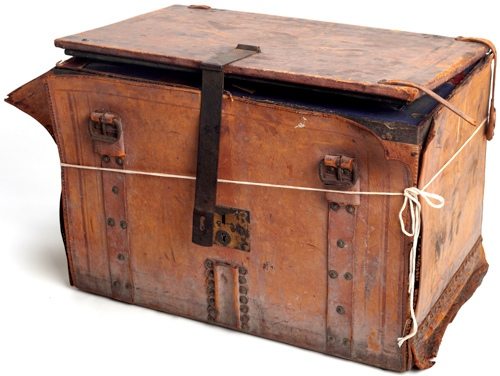The chest is leather-bound and rust-colored. The leather pulls away from the metal frame in places and frays in others. The chest’s dimensions are 15 in. x 21 in. x 14 in. It has a metal hasp and buckles, which once helped keep it locked. Union Army markings identify it as a Civil War container.
Its contents: a used candle, a shaving brush and blade sharpener, quills, an ink jar, two boot brushes, bar soap, buckles, bullets called minié balls, a cannon ball fragment, a purple sash, buttons, epaulettes, and uniform patches. All of this is known. Who owned the chest and how it came into the possession of the William H. Hannon Library Archives and Special Collections, however, is not known.
To Cynthia Becht, head of Archives and Special Collections, the chest is a great mystery. The simple, day-to-day implements probably belonged to an officer who could transport personal possessions with him during a campaign. The trunk may have belonged to Gen. William Rosecrans, a Union general who moved to Los Angeles after the war’s end. Books and other materials of Rosecrans are kept in Hannon Library. As to the chest’s origin and history of possession, she says, “We have not yet found one shred of written evidence.”
For Carla Bittel, associate professor of history who studies the 19th century, the unremarkable nature of the chest’s articles makes them intriguing.
“These items are less notable for their market value and more important for capturing daily life in wartime, especially off the battlefield,” Bittel says. “They are the material culture of camp life.”
In 2005, Bittel asked Becht to display the library’s Civil War materials to her history class. Although Becht immediately thought of the chest, she had never looked inside. When she did and saw the trove of implements, “It was like Christmas!” she says. Now she and Bittel collaborate whenever Bittel teaches the course.
The professor sees the trunk as a way “to teach the students how historians deal with source material, and the trunk is a legitimate example of a primary source. It’s part of the material culture of the time.”
Becht knows her job is to establish the chest’s history of possession, its provenance. Yet she relishes the challenge the chest presents to the students, who are scholars in training. “It would be sad in a way,” she muses, “if there were no more mysteries.”

